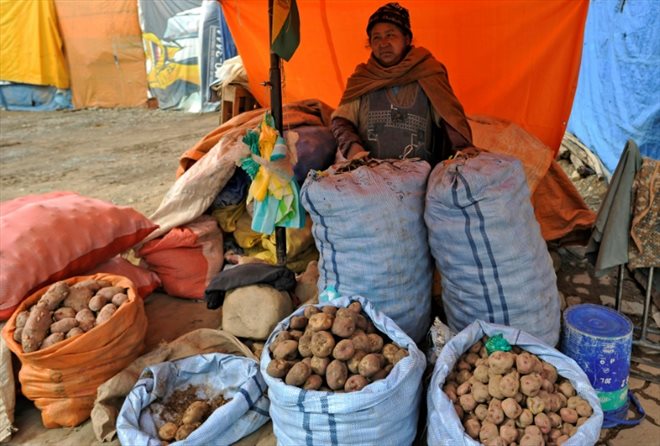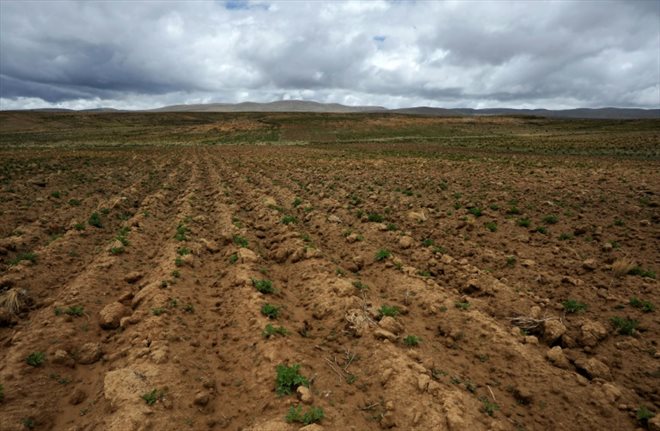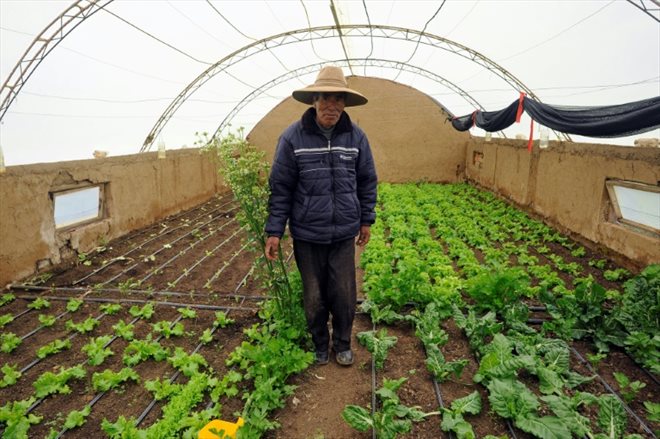Cristobal Pongo shows a desiccated potato plant in a field on February 8, 2023 in Caluyo, south of La Paz, Bolivia (AFP/JORGE BERNAL)
The dozens of furrows of a vast plowed field in the Bolivian highlands are desperately empty.
Frost and drought have taken over the potato plants in this region affected by climate change.
Like many farmers of the Aymara Amerindian ethnic group in the region, Cristobal Pongo has devoted his life to the cultivation of tubers.
“Our income comes down to potatoes. We harvest, we sell… It is our means of subsistence, that of our family, so that our children can study”, explains the 64-year-old man, kneeling in his field, some 4,000 meters above sea level.
But this year, the farmer will have nothing to sell at the Calamarca market, 70 kilometers from La Paz.

Cristobal Pongo in front of his greenhouse where he grows potatoes, on February 8, 2023 in Caluyo, south of La Paz, Bolivia (AFP/Jorge Bernal)
“The frost killed the potato… It no longer grows, look, it is dead”, he laments, walking through his field in search of any plants that may have survived.
The shortage has multiplied by up to seven the price of the tuber, which sells for almost two dollars per kilo in some markets in the country where poverty affected 36% of the population in 2021, according to official data.
Late rains and summer frosts wiped out harvests, which experts say is no coincidence.
“The highlands, in particular, are vulnerable to (climate) changes and these changes are manifesting themselves today: there is a rainfall deficit”, warns Luis Blacutt, expert in atmospheric physics at the University Mayor of San Andres.
The explanation, he said, lies in the fact that the region receives up to 70% of its annual rainfall between November and March, but last year the rain fell only from the end of December.

A potato seller in the El Alto market on February 8, 2023 in Bolivia (AFP / JORGE BERNAL)
The delay has also taken its toll in neighboring Peru’s Andean region, which in December declared a 60-day state of emergency in more than 100 districts due to drought.
There are more than 4,000 edible varieties of potato in the world, making it the third most consumed food crop after rice and wheat.
Most of these varieties are found in the Andes of South America, according to the International Potato Center, based in the Peruvian capital Lima.
– “Serious consequences” –
Already in 2010, a study in the journal Annals of the Association of American Geographers warned that “climate change in the highlands could have serious consequences for water management and indigenous agriculture”.

A potato field affected by extreme weather conditions on February 8, 2023 near Vilaque, Bolivia (AFP/Jorge Bernal)
Another study published in 2019 by Frontiers in Environmental Science “confirms the influence of human-induced climate change (…) on the negative changes in precipitation on the highlands in recent decades”.
In the meantime, Cristobal Pongo does not know how he will survive this season. There will be no harvest before April and he will have to wait until the end of October to be able to sow again.
If the rains don’t come by then, he will still have to wait because the soil needs to be moist for the potatoes to germinate. If he waits too long, the winter frosts, which come earlier and earlier, could again destroy the fruit of his labor.
Faced with uncertainty, like a few other farmers in the region, he installed greenhouses on his land with the support of the local NGO Cipca.

Cristobal Pongo in his greenhouse where he grows potatoes and other vegetables, on February 8, 2023 in Caluyo, south of La Paz, Bolivia (AFP/Jorge Bernal)
“If you can’t produce in the open field, you can somehow produce in controlled environments like solar greenhouses,” says Orlando Ticona, an NGO technician who could not say. how many families had received such facilities.
However, greenhouse production is still limited to small areas in the region.
“I have no hope”, assures Cristobal Pongo about his plantations this year. But, “if it rains, there will be a good production” next year, he adds hopefully.
© 2023 AFP
Did you like this article ? Share it with your friends with the buttons below.




